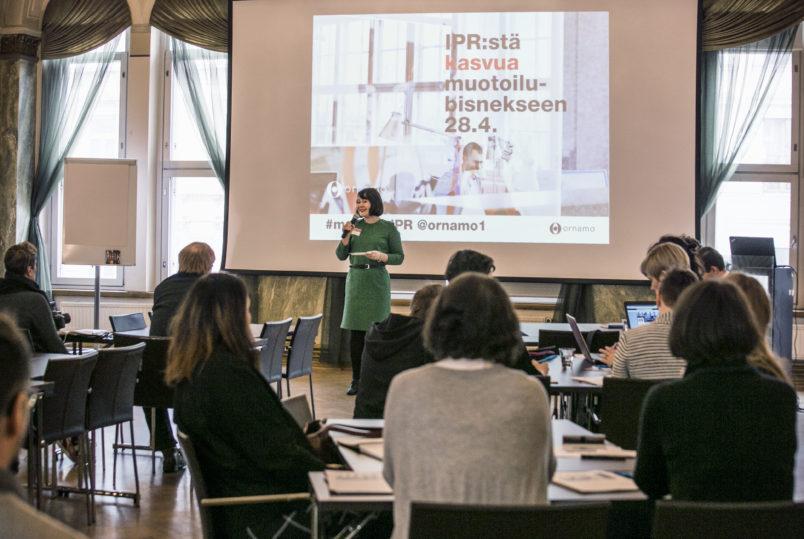What should every designer know about intellectual property?

Enterprises face rapidly growing needs for information on the utilization of intellectual property rights (IPR) in their business strategies. The IPR-intensive industry already represents 50 percent of the entire EU economy, which illustrates a significant shift in the EU economic structure.
It pays off to emphasize intangible assets and IPR in business strategies, states the Finnish Association of Designers Ornamo. It has launched a long-term project to increase the understanding of design and intellectual property creation especially among small and medium enterprises.
Three aspects to remember about IPR
At the end of April, Ornamo brought to Finland Tom Carver, an IPR expert who is also a specialist in the Chinese market, to speak about IPR at a seminar on growth in the design business. Carver presented to the audience the IPR strategy of the technology company Dyson and the impact of the strategy on the company’s positive achievements in the Chinese market.
The seminar also featured Vertti Kivi, CEO of the interior design company dSign, and lawyer Antti Innanen, who shared his views about protecting brands on the online, global marketplace.
The seminar launched the Ornamo programme under the theme intellectual property creation from design. Based on the presentations by the experts, Ornamo has put together three aspects that every designer should know about intangible assets and intellectual property.
1. Intangible assets surpass tangible assets
Today corporate value formation increasingly takes place in the world of IPR, story telling and images. For example, the value of Apple is not in the existing devices but in the potential provided by the devices – in how the brand could be used and expanded further. And how to associate images of high quality with more and more new products.
– Lawyer Antti Innanen
Consequently, today’s enterprises should focus on the world of intellectual property. The IPR-intensive industry already represents 50 percent of the entire EU economy. The intangible, digital world can bring significant added value to many fields: for example, cars operated on the Uber platform and dwellings rented through Airbnb exist in the framework of the intangible reality and can be shared.
2. Design produces growth in intangible assets for customers
It’s important today to understand not only the customer but the customer of the customer’s customer.
– Vertti Kivi, CEO of interior design company Vertti Kivi & Co
Design is a key factor in intellectual property creation and, as such, it is of crucial importance for the growth and competitiveness of other fields. The new wave of business emphasizes the customer experience and business activity oriented towards satisfying customer needs. The user-oriented and engaging approach applied by designers is of high value to enterprises. This approach makes products and services attractive and meaningful to users.
According to Vertti Kivi, it is important for enterprises to familiarize themselves with the needs of customers and to design interiors and products on the basis of these needs – and not to move from one enterprise to another offering one and the same chair for production. The latter approach also involves a danger of copying if the product is not protected.
3. Brand before products
Often a design company first designs products and then sets out to reflect on the brand to create around those products. Antti Innanen challenged design companies to consider moving forward with the brand first. As an example, he presented the strong brand story of Finnish Kyrö Distrillery Company.
Innanen suggested that the creation of a business idea should also be considered from the angle of exclusivity: what specialized field could I focus on to have a monopoly in that field? With exclusive rights, an enterprise stands on firm ground to start building a believable story and unique products or services. Without exclusivity, a brand is always at least somewhat vulnerable.

According to an Ornamo economic survey, an increasingly large share of product value is related to a product’s brand value, usability, related services and other immaterial value creation, tells Ornamo Design Expert Asta Boman-Björkell in the seminar handling IPR and growth in the design business.
Protection of IPR as an investment that boosts corporate value
According to an Ornamo economic survey, an increasingly large share of product value is related to a product’s brand value, usability, related services and other immaterial value creation. The survey concludes that design enterprises and entrepreneurs possess inadequate skills in the management of intellectual property rights.
As the traditional earnings practice changes, the design-intensive business will increasingly focus on the utilization of intellectual property, such as copyrights, utility models and trademarks. Understanding intellectual property creation is a prerequisite for corporate growth.
– IPR protection is seen as an additional expense, although it is an investment that boosts corporate value,” Boman-Björkell affirms.
– The management of intellectual property rights protects a business against violations of IPR and gives assurance to investors and partners.
According to corporate surveys conducted by the Confederation of Finnish Industries and Ornamo, only 20 percent of Finnish enterprises utilize design in their operations. Design is utilized by one in three small and medium industrial enterprises. According to the enterprises surveyed, design can be used to create strong products, services and brands, which can distinguish enterprises from their competitors and enable them to raise the prices of products.
– Economic development based on intellectual property creation is key to growth in the design sector and the Finnish economy, which sets new types of requirements for design-intensive enterprises to reform their business operations, says Ornamo Design Expert Asta Boman-Björkell.
Design as a sector producing intangible assets is one of the main drivers of intellectual property creation emphasized by the current Finnish government.
Enterprises that apply such models average 31 percent higher revenue per employee compared with enterprises that do not apply such models, as revealed by a survey conducted by the European Union Intellectual Property Office (EUIPO) and the European Patent Office (EPO).
